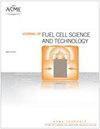Experimental Investigation on the Performance of a Formic Acid Electrolyte-Direct Methanol Fuel Cell
引用次数: 11
Abstract
The performance of a new methanol fuel cell that utilizes a liquid formic acid electrolyte, named the formic acid electrolyte-direct methanol fuel cell (FAE-DMFC) is experimentally investigated. This fuel cell type has the capability of recycling/washing away methanol, without the need of methanol-electrolyte separation. Three fuel cell configurations were examined: a flowing electrolyte and two circulating electrolyte configurations. From these three configurations, the flowing electrolyte and the circulating electrolyte, with the electrolyte outlet routed to the anode inlet, provided the most stable power output, where minimal decay in performance and less than 3% and 5.6% variation in power output were observed in the respective configurations. The flowing electrolyte configuration also yielded the greatest power output by as much as 34%. Furthermore, for the flowing electrolyte configuration, several key operating conditions were experimentally tested to determine the optimal operating points. It was found that an inlet concentration of 2.2 M methanol and 6.5 M formic acid, as along with a cell temperature of 52.8 °C provided the best performance. Since this fuel cell has a low optimal operating temperature, this fuel cell has potential applications for handheld portable devices.甲酸电解质-直接甲醇燃料电池性能的实验研究
实验研究了一种采用液态甲酸电解质的新型甲醇燃料电池——甲酸电解质-直接甲醇燃料电池(FAE-DMFC)的性能。这种类型的燃料电池具有回收/洗涤甲醇的能力,无需甲醇-电解质分离。研究了三种燃料电池结构:流动电解质和两种循环电解质结构。在这三种配置中,流动电解质和循环电解质(电解质出口通往阳极入口)提供了最稳定的功率输出,在各自的配置中,性能衰减最小,功率输出变化小于3%和5.6%。流动的电解质结构也产生了最大的功率输出,高达34%。此外,对于流动电解质配置,实验测试了几个关键操作条件,以确定最佳操作点。实验结果表明,甲醇进口浓度为2.2 M,甲酸进口浓度为6.5 M,电池温度为52.8℃时性能最佳。由于该燃料电池具有较低的最佳工作温度,因此该燃料电池在手持便携式设备上具有潜在的应用前景。
本文章由计算机程序翻译,如有差异,请以英文原文为准。
求助全文
约1分钟内获得全文
求助全文
来源期刊
自引率
0.00%
发文量
0
审稿时长
6-12 weeks
期刊介绍:
The Journal of Fuel Cell Science and Technology publishes peer-reviewed archival scholarly articles, Research Papers, Technical Briefs, and feature articles on all aspects of the science, engineering, and manufacturing of fuel cells of all types. Specific areas of importance include, but are not limited to: development of constituent materials, joining, bonding, connecting, interface/interphase regions, and seals, cell design, processing and manufacturing, multi-scale modeling, combined and coupled behavior, aging, durability and damage tolerance, reliability, availability, stack design, processing and manufacturing, system design and manufacturing, power electronics, optimization and control, fuel cell applications, and fuels and infrastructure.

 求助内容:
求助内容: 应助结果提醒方式:
应助结果提醒方式:


